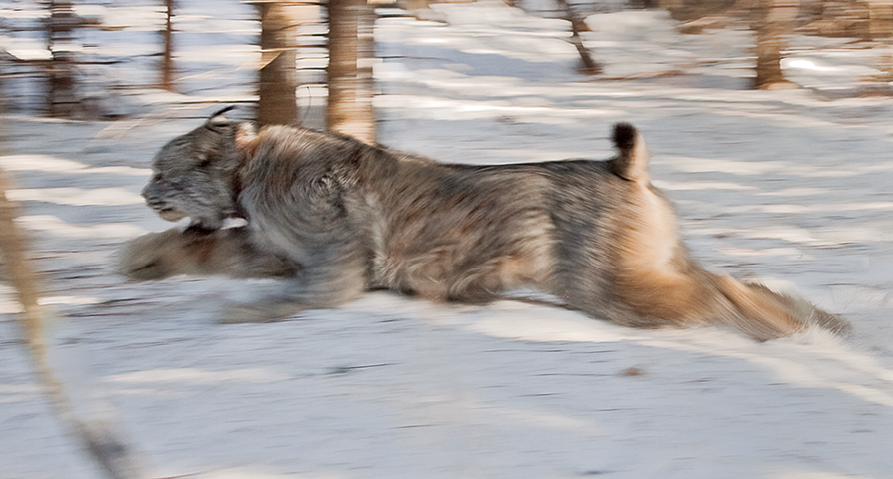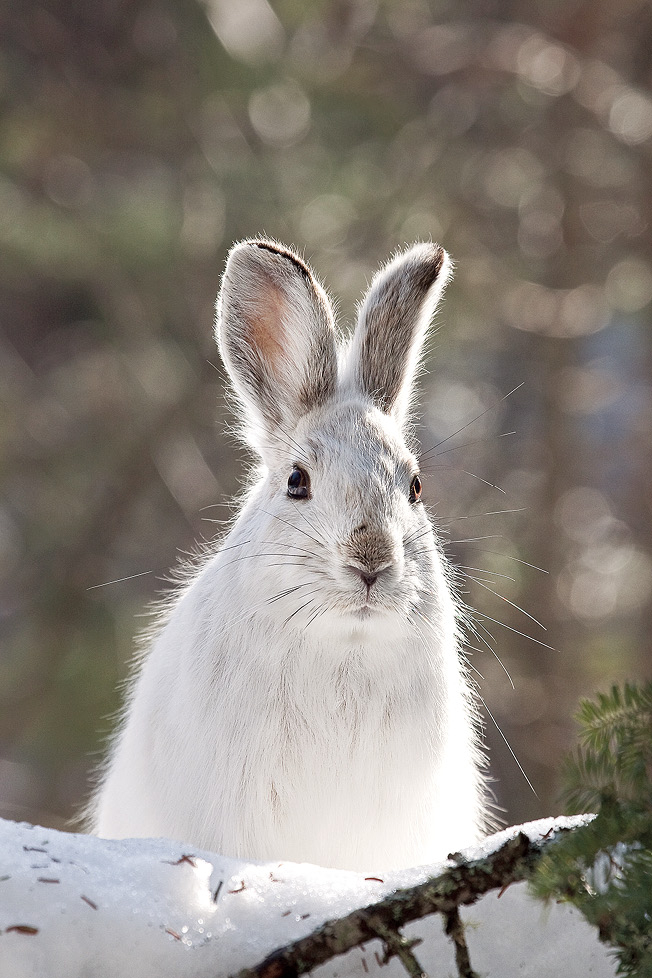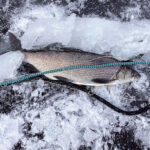Rainbow arcs above
Treasure waiting very near:
Lynx in autumn light.
Shadow in the Forest
The forest has eyes. And somewhere in an October dawn that rises over Lake County, just south of the Canadian border, they’re watching.
The eyes of the Canada lynx, an elusive northern forest cat, have the advantage in thick boreal, or northern spruce-fir, forest. They see without being seen. “Keeper of the secrets of the forest,” the lynx is called by Native Americans. Don’t look for a lynx, others say; a lynx must find you. And so it turns out to be.
Voices muffled by parka collars, our small group of naturalists sets out from Ely in search of moose. But the Northwoods offers gifts of its own choosing, and today’s will be feline, not ungulate.
Fall colors turn Lake County’s wooded hills and mountains a palette from crimson to flame to gold. Our 4×4 bumps along Little Manitou Road, then rounds a corner between Isabella and Finland. A rainbow arcs overhead, a reminder of a brief rain shower just minutes earlier. Suddenly, there’s movement in the trees and we screech to a halt, thinking we’ve spotted a bobcat.
Creeping forward for a better look, we’re enveloped in boreal forest silence, a soundlessness so complete we might be astronauts walking in the blue emptiness of space. We cautiously step out, edging a few feet toward a thicket of firs and alders. Just at the edge of sight is an animal that’s rarer than a bobcat: a Canada lynx.
Canada lynx range across Alaska, Canada, and the northernmost part of the contiguous U.S. No other cat-of-the-snows has long, dense fur, triangular ears with black tufts at the tips, and huge paws.
Lynx roam boreal forests in a hindquarters up, head down posture. Circling around lakes and alder swamps, they leave pawprints in mud or snow, often visible only to those trained to track them. But today a lynx has indeed found us.
Ever closer it moves, rustling through the alders as it makes its way through piles of broken tree limbs and over logs on the forest floor. Then the thicket opens and translucent green eyes meet ours. The eyes of a creature so solitary and shy it’s rarely seen in the wild. Long black ear tufts stand straight up. In a moment suspended in time, lynx and forest meld, becoming one.
Cat-of-the-Snows
Here in The Boreal, as it’s known, lynx appear to have it all: their main prey, snowshoe hares; the brushy woods the hares prefer; and the deep winter snows to which lynx and hares have adapted. Both have thick cushions of hair on the soles of their large feet, which act like snowshoes.

Where there’s boreal forest, there are snowshoe hares and lynx. Or so it has been. Lynx were once found in 24 U.S. states but now occur in just seven, according to biologists Robby Marrotte of Trent University in Peterborough, Ontario, and Jeff Bowman of the Ontario Ministry of Natural Resources, writing in the journal Ecology and Evolution.
In addition to Minnesota, U.S. states with Canada lynx populations are Maine, New Hampshire, Montana, Idaho, Washington, and Colorado. The lynx is designated as threatened in the contiguous U.S. But in Canada, lynx still occupy 95 percent of their historical range. They’re provincially endangered in Nova Scotia and New Brunswick, however, and have been extirpated from Prince Edward Island.
Lynx reproduction is in sync with that of their hare prey. Snowshoe hare numbers peak every 10 years, with lynx numbers reaching highs a year later. But the lynx-hare cycle isn’t as clear in the southernmost parts of these species’ range, such as Minnesota. There boreal forest begins to peter out, and with it, numbers of snowshoe hares and lynx. It’s one of the reasons for international research on the connections between Ontario and Minnesota lynx.
“During peak years, individuals venture south and colonize marginal habitat outside of the boreal forest in Ontario and eventually reach the northern Great Lakes states,” state Marrotte and Bowman.
Ambassadors of The Boreal, Minnesota lynx in search of meals or mates regularly visit their neighbors to the north in Canada. The same is true of Ontario lynx, which frequently make their way south.
Scientists on both sides of the Canada-U.S. line are working to discover how much lynx interbreeding happens, and to what extent the future of one lynx population depends upon the other, especially for lynx south of the border.
In Minnesota, lynx may number as few as 100 to 300, according to wildlife biologist John Erb of the Minnesota Department of Natural Resources. Other states in the U.S. where lynx still exist also likely have small populations. Because lynx are so secretive, however, population estimates are just that—estimates. And whatever those numbers are today, they may not be for long.
In a warming climate, the boreal forest is shifting northward. “Soon that will become critical for Minnesota’s lynx,” says forest ecologist Lee Frelich of the University of Minnesota. “It will be crucial for lynx in Canada, too, in coming years. To see the future, Canadian wildlife biologists need only look south.”

For now, that view is of boreal forest that stretches unbroken from northern Minnesota to Ontario and beyond. Fir tree after fir tree stand for hundreds of miles like sentinels, their watch relieved only by the lakes that dot the landscape.
Emissaries of The Boreal
With expanses of boreal forest for lynx to wander, the frequency of their cross-border travels has turned out to be much higher than scientists anticipated. One enterprising lynx swam across Saganaga Lake in the Boundary Waters Canoe Area Wilderness; the line between Canada and the U.S. runs down the middle of the lake. Biologists say that the two populations of lynx should be considered together.
Whether Minnesota had its own population of Canada lynx was long debated. In 2002, Joe Foster of Foster Logging in Isabella found proof that it does. Foster and his uncle videotaped what would become the first documentation of lynx reproduction in Minnesota: a mother lynx with young. Then in spring, 2004, and subsequent springs, scientists located lynx dens and a female lynx with kittens near Isabella. Whether lynx born in Minnesota will remain in-state, go north, or move back and forth, no one knows.
Studies to date offer a surprising hint. The success of a lynx population depends not on old-growth forest, as had long been thought, but on early successional forest—woods with trees between 10 and 30 years old. Snowshoe hares hide there in young thickets or “edgerows,” the northern wilderness equivalent of the hedgerows where suburban rabbits hop.
Sections of Lake County are at the center of a northern spruce-fir forest in early successional stages. Stands periodically harvested for timber are scattered across the region. Many have young trees springing up amid a lynx favorite: jumbles of downed branches atop scrubby undergrowth. Logging isn’t all bad for lynx, say some researchers. In many ways, they believe, it’s the modern equivalent of fires that once burned and are now often suppressed by forest management plans.
In the U.S. and Canada, it’s usually male lynx who wander farthest afield. Females, probably because they have kittens, often—but not always—have smaller territories. Lynx home ranges vary; they may stretch from three to 300 square miles. That includes across international boundaries, which mean nothing to a lynx.
In late winter, lynx border-cross in earnest, perhaps to find mates. From International Falls in Minnesota to Rainy Lake in Ontario; Quetico Provincial Park in Ontario to the Gunflint Trail in Minnesota, lynx connect Canada and the U.S.
Today’s October woods will soon become white. Where snows are deep and winters long, the Northwoods indeed has eyes, on both sides of the international line. For now. When warm winds someday blow through forests that have turned from spruce and fir to oak and maple, Minnesota’s lynx will have moved north for good, truly becoming Canada lynx.





